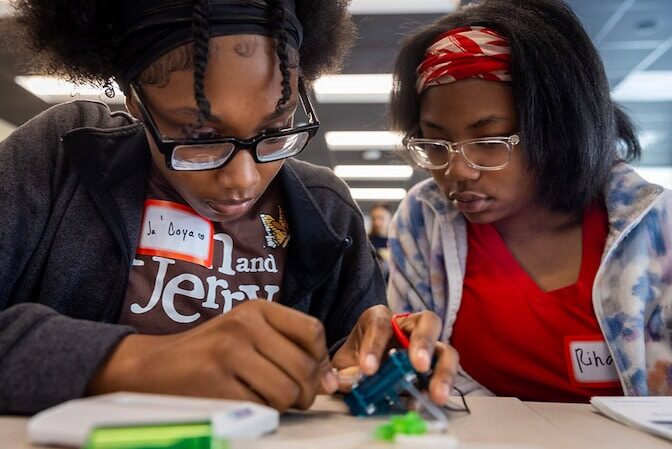Source: College of Engineering

Ja’Coya Jordan and Rihanna Goree fill up the hydrogen balloon, connected to the electrolyzer (blue box). Credit: Marcin Szczepanski, Michigan Engineering.

Julius Crooks Jr. (blue sweatshirt) reacts with amazement after the car he built moves fast on the track. Keywan Diggs has a hand over his mouth, and Jason Allen Jr. stands beside him as they wait their turn. MEZ director Haley Hart stands on the right of the photo. Credit: Marcin Szczepanski, Michigan Engineering.
Last Friday, 27 eighth graders from Henderson Academy in Detroit were the first to build and race model hydrogen cars at the Michigan Engineering Zone.
The day opened with an overview by Haley Hart, director of the MEZ, on climate change and how excess carbon dioxide from industry and transportation strengthens the greenhouse effect. Then Dante Vozza, lead STEM instructor at the MEZ, took the floor to introduce hydrogen as an alternate fuel, comparing and contrasting hydrocarbons, such as gasoline, with water.
Transitioning over to the technology the students would be using, he gave a basic rundown of how electrolyzers and fuel cells work. The electrolyzer uses electricity to split water, making hydrogen and oxygen, and the fuel cell combines oxygen with hydrogen to produce water and electricity.
“One of the huge things you might notice about these two diagrams is they look pretty similar,” said Vozza. “In physics, there are processes that work in both directions. What the electrolyzer does, the hydrogen fuel cell undoes.”
Then, the students paired up and got to work. The first thing they had to do was get the energy system working, with an electrolyzer and fuel cell each a little smaller than a deck of cards, and a hydrogen canister the size of a C battery. They filled the electrolyzer with water and hooked it up to the canister and a pair of AA batteries, watching the balloon inside the canister fill with hydrogen.
Next, they attached the hydrogen canister to the fuel cell and connected the motor. When they released the hydrogen into the fuel cell, the motor turned. This was a magic moment for many of the teams.
“It’s spinning!” Gawhar Mohammadzoi, 6th grade, shouted when his team’s motor started up.
Once the energy system was tested and working, the teams set about assembling a car around it. Most students were highly engaged in construction, attaching the brackets that held the power system and axles to the base plate, and then mounting the wheels. The 1:20 scale cars would fit neatly inside a shoebox.
“Can either of you see yourself doing something like this for a living?” Latrena Marshall, middle school counselor, asked Julius Crooks Jr. and his partner, both in 8th grade. True to teenage form, they didn’t show too much enthusiasm as they nodded, but they were the furthest along with the build.
“This is the first time with hydrogen, but I’ve been bringing kids here to the Thinkabit lab for years. They love it. It’s hands-on exposure, learning to work with different parts,” said Marshall.
After more than an hour of building, Crooks and his partner took to the track for the first successful test. The car went about eight feet.

Ja’Coya Jordan and Rihanna Goree fill up the hydrogen balloon, connected to the electrolyzer (blue box). Credit: Marcin Szczepanski, Michigan Engineering.
“I was really impressed with how quickly the students jumped right in to build the cars. They showed that persistive and iterative spirit you need with engineering,” said Hart.
The teams encountered struggles familiar to most engineers. The hydrogen leaked out when the tubes weren’t completely clamped. When the gears weren’t fully aligned, they didn’t mesh consistently. In one tragic case, a nearly-assembled car slipped off the table.
“The instructions, it was easy, but the pieces kept coming apart—especially the tires,” said Rihanna Goree, 7th grade.
This was a common experience. The o-ring-style tires fell off the wheels, and the drive wheel would whine on the test track as it spun without traction. Even so, she and her partner, Ja’Coya Jordan, 7th grade, didn’t let the challenges dampen their spirits.
“It felt fun putting it on the track,” said Goree.
“Once we had more patience, it became more fun,” Jordan observed.

Henderson Academy’s students Damontay Shufford (left) and Zadrian King work with Haley Hart, director of the MEZ on testing the car they built. Credit: Marcin Szczepanski, Michigan Engineering.
After another half an hour of building and testing, a car reached the end of the 30-foot blue track for the first time—built by Keywan Diggs and Jason Allen Jr., 8th grade.
“It felt good after all the struggles,” said Diggs.
“After the time we put into this, to see this work,” Allen Jr. added.
At the end of the day, Hart got a room full of thumbs-up when she polled the group on how they liked the activity, with just a few dissenters.
“You all were the first ones to do this, and you’re helping us to make this better,” she said.
For one, she and her team will figure out how to modify the wheel construction to keep those tires on.
Hart draws a parallel with the hydrogen industry itself. “We built excitement around hydrogen, but there is still a lot of room for the technology and infrastructure to grow and create a functional hydrogen economy,” she said.
The event was sponsored by MI Hydrogen, the University of Michigan’s hydrogen initiative, which provided Hydrogen Grand Prix (H2GP) kits from Horizon Educational.
“MI Hydrogen is excited to introduce these younger students to possibilities of hydrogen power in moving to a net-zero world,” said Todd Allen, co-director of MI-Hydrogen.
The University of Michigan participates in the Department of Energy’s Midwest Alliance for Clean Hydrogen (MACH H2) energy hub, and other members of MACH H2 also collaborate with the H2GP Foundation to run regional hydrogen car competitions.

